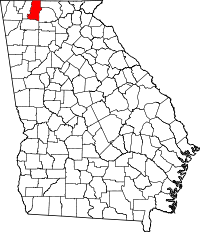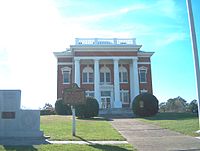- Murray County, Georgia
-
Murray County, Georgia Murray County courthouse in Chatsworth, Georgia
Location in the state of Georgia
Georgia's location in the U.S.Founded 1832 Seat Chatsworth Largest city Chatsworth Area
- Total
- Land
- Water
346.88 sq mi (898 km²)
344.41 sq mi (892 km²)
2.47 sq mi (6 km²), 0.71%PopulationEst.
- (2007)
- Density
40,664
106/sq mi (41/km²)Time zone Eastern: UTC-5/-4 Murray County is a county located in the U.S. state of Georgia. As of 2000, the population was 36,506. The 2007 Census Estimate showed a population of 40,664.[1] The county seat is Chatsworth.[2]
It is part of the Dalton, Georgia, Metropolitan Statistical Area.
Contents
History
In December, 1832 the Georgia General Assembly designated the extreme northwestern corner of the state as Murray County. Formerly part of Cherokee County, the area was named for a distinguished Georgia statesman from Lincoln County, Mr. Thomas W. Murray, a former speaker of the Georgia House. Within a short time the legislature found the county was too large to administer properly as the population grew, for the county then included what is now Dade, Walker, Catoosa, Whitfield, Murray, Gordon and parts of Bartow and Chatooga Counties, so further division became necessary. Within two decades, Murray County came to be 342 square miles (886 km2) of land with Spring Place as its county seat until the railroad was built through Chatsworth, and made Chtsworth more accessible, the county seat was moved to Chatsworth.
Cherokees
The area was in the heart of the Cherokee Nation at the time the boundary lines were drawn through the territory. Not until after the Cherokees were removed in 1838–39 did white settlers enter the county in large numbers. Spring Place had been established in 1801 as a Moravian mission to the Cherokee and had been a post office since 1810 – the second oldest in North Georgia. Soon after the Cherokee "Trail of Tears", the white people who had drawn or purchased Murray County land lots of 160 acres (0.6 km2) in the Georgia Land Lottery were pouring into the area.
Civil War
At the outbreak of the American Civil War Murray County had no industry and very little wealth. When Georgia seceded from the Union, hundreds of men and boys from Murray answered the call and went to fight for the Confederacy. Many would never return home. The following units were from Murray County:
3rd Battalion, Georgia Infantry, Company B, Spring Place Volunteers
11th Regiment, Georgia Infantry, Company C, Murray Rifle Company
22nd Regiment, Georgia Infantry, Company D
37th Regiment, Georgia Infantry, Company A
39th Regiment, Georgia Infantry, Company A, Cohutta Rangers
39th Regiment, Georgia Infantry, Company B
19th State Troops – Capt. John Oats Company
In 1864, two skirmishes between Union and Confederate soldiers took place just to the west of Spring Place, one of which took place on June 25, 1864 with the 8th Michigan Cavalry US. The First Tennessee Cavalry CS skirmished about 5 miles north of Spring Place on April 19, 1864. A skirmish took place near Westfield late during the night of August 22, 1864. Captain Woody of the Murray County Home Guard was reported wounded.
On February 27, 1865 and April 20, 1865 there was a skirmish at Spring Place between Confederates and the 145th Indiana Infantry US. This was followed by a skirmish on Holly Creek on March 1, 1865. By 1865 Spring Place was known as an area occupied by Confederate Guerrillas. During March 20–22, 1865 Union soldiers made an attempt to suppress this activity.
Railroad
In 1906, after two earlier attempts at building a railroad in Murray County had failed, the Louisville and Nashville line was built to run north to south through the entire length of the county. Murray grew, with new towns developing along the railroad. One of these new towns was named Chatsworth. With the new railroad line in place, timber could be shipped out of the mountains, and talc deposits, discovered in the 1870s, was able to be mined and the ore shipped throughout the country.
The old county seat of Spring Place was bypassed by the railroad. Some Murray Countians began an effort to move the county seat to the more central and accessible railroad town of Chatsworth. Much dissention was caused by this effort. A county-wide referendum was held on the matter in 1912, which resulted in Chatsworth being named as the seat of local government, where it remains to present day.
Into the twentieth century, Murray remained predominantly agricultural. Shortly after World War II the textile industry, prevalent in neighboring Whitfield County, began move into Murray. Today, the carpet industry is the predominant employer in Murray County.
Attractions
The Chief Vann House Historic Site at Spring Place. Constructed in 1805 for James Vann, a Cherokee chief, the two-story red brick home was built alongside the Federal Road, a major early path in northwest Georgia.
Fort Mountain State Park. A 3,712-acre (15 km2) park in the Cohutta Mountains.
Another major asset is the Chattahoochee National Forest, which occupies a large portion of northeastern Murray County. Within the forest is the Cohutta Wilderness Area, a roadless, mountainous landscape featuring several of Georgia's premier backpacking trails.
Carters Lake, on the Coosawatee River, was formed by the Carter Dam, which is the largest earth-rock dam east of the Mississippi. The 3,200-acre (13 km2) lake attracts fishermen, boaters and campers.
Lake Conasauga located near the summit of Grassy Mountain was built by the Civilian Conservation Corps in 1940 and is the highest lake in Georgia at 3,150 feet (960 m) above sea level.
Geography
According to the 2000 census, the county has a total area of 346.88 square miles (898.4 km2), of which 344.41 square miles (892.0 km2) (or 99.29%) is land and 2.47 square miles (6.4 km2) (or 0.71%) is water.[3]
Major highways
 U.S. Highway 76
U.S. Highway 76 U.S. Highway 411
U.S. Highway 411 Georgia State Route 2
Georgia State Route 2 Georgia State Route 52
Georgia State Route 52 Georgia State Route 61
Georgia State Route 61 Georgia State Route 136
Georgia State Route 136 Georgia State Route 225
Georgia State Route 225 Georgia State Route 282
Georgia State Route 282 Georgia State Route 286
Georgia State Route 286
Adjacent counties
- Polk County, Tennessee (northeast)
- Fannin County (east-northeast)
- Gilmer County (east)
- Gordon County (south)
- Whitfield County (west)
- Bradley County, Tennessee (northwest)
National protected area
- Chattahoochee National Forest (part)
Holly Creek
Demographics
As of the census[4] of 2000, there were 36,506 people, 13,286 households, and 10,256 families residing in the county. The population density was 41/km² (106/mi²). There were 14,320 housing units at an average density of 16/km² (42/mi²). The racial makeup of the county was 95.30% White, 0.62% Black or African American, 0.29% Native American, 0.25% Asian, 0.01% Pacific Islander, 2.64% from other races, and 0.88% from two or more races. 5.49% of the population were Hispanic or Latino of any race.
There were 13,286 households out of which 39.00% had children under the age of 18 living with them, 60.80% were married couples living together, 11.10% had a female householder with no husband present, and 22.80% were non-families. 18.80% of all households were made up of individuals and 6.00% had someone living alone who was 65 years of age or older. The average household size was 2.73 and the average family size was 3.10.
In the county the population was spread out with 28.00% under the age of 18, 9.50% from 18 to 24, 33.00% from 25 to 44, 21.50% from 45 to 64, and 8.00% who were 65 years of age or older. The median age was 33 years. For every 100 females there were 99.90 males. For every 100 females age 18 and over, there were 97.50 males.
The median income for a household in the county was $36,996, and the median income for a family was $42,155. Males had a median income of $29,812 versus $23,035 for females. The per capita income for the county was $16,230. About 9.20% of families and 12.70% of the population were below the poverty line, including 15.90% of those under age 18 and 19.40% of those age 65 or over.
Cities and towns
- Chatsworth
- Eton
- Cisco (Unincorporated)
- Tennga (Unincorporated)
- Crandall (Unincorporated)
- Spring Place (Historical Township)
- Ramhurst (Unincorporated)
- Carters (Unincorporated)
- Ball Ground (Unincorporated)
- Floodtown (Unincorporated)
- Sumac (Unincorporated)
- Fashion (Unincorporated)
See also
References
- ^ [1]
- ^ "Find a County". National Association of Counties. http://www.naco.org/Counties/Pages/FindACounty.aspx. Retrieved 2011-06-07.
- ^ "Census 2000 U.S. Gazetteer Files: Counties". United States Census. http://www.census.gov/tiger/tms/gazetteer/county2k.txt. Retrieved 2011-02-13.
- ^ "American FactFinder". United States Census Bureau. http://factfinder.census.gov. Retrieved 2008-01-31.
External links
- http://www.murraycountychamber.org/history2.htm
- http://www.ourchatsworth.com
- http://www.murraycountymuseum.com
- http://www.chatsworthtimes.com
- http://murrayga.genealogyvillage.com/ Murray County Genealogy & History

Bradley County, Tennessee Polk County, Tennessee 
Whitfield County 
Fannin County and Gilmer County  Murray County, Georgia
Murray County, Georgia 

Gordon County Municipalities and communities of Murray County, Georgia City Town Unincorporated
communitiesCategories:- Georgia (U.S. state) counties
- Murray County, Georgia
- 1832 establishments in the United States
- Populated places established in 1832
- Dalton metropolitan area
Wikimedia Foundation. 2010.


